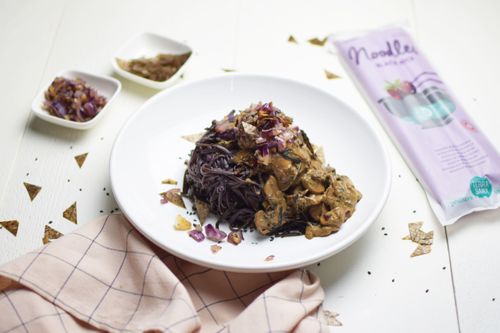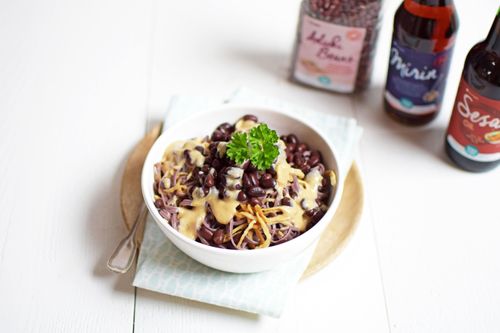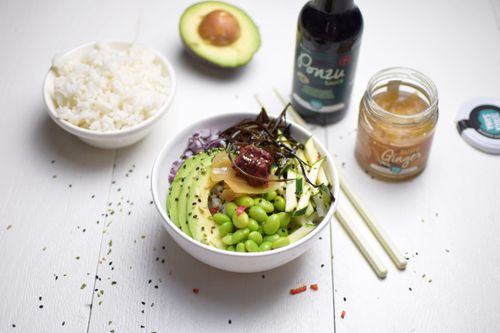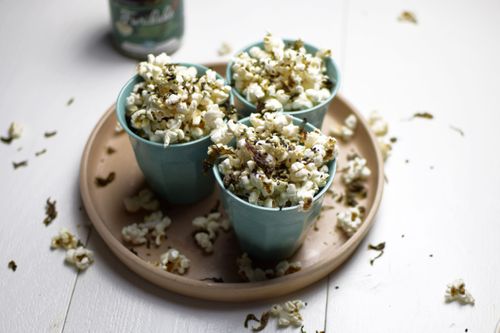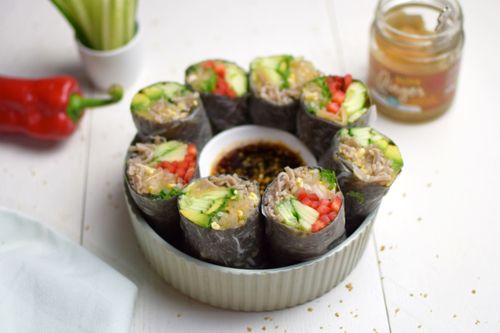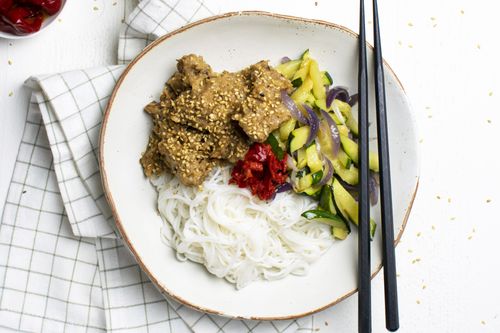What is furikake? And how does it differ from gomasio?

What is furikake?
Furikake is a trendy mix of seaweed and two colors of sesame seeds. It adds both color and flavor to your salad, soup, sushi, or noodle dish. Double trouble!
Sometimes furikake also contains dried fish, egg or even sugar. If you prefer to keep your diet pure and plant-based, then opt for the authentic mix of sesame, seaweed and possibly salt. In any case, make sure you buy furikake without sugar, because even in Japan this is really a no-go. Preferably choose authentic furikake!
What is gomasio
Gomasio (also known as gomashio) is a mix of crushed sesame seeds and sea salt. So just as good a topping or flavouring as furikake, but without the seaweed. Gomasio is super delicious over your noodles or rice, salad or wrap.
These are the benefits of gomasio and furikake:
- They are a great substitute for salt
- They are both rich in protein
- They are quick flavor enhancers and perfect as a finishing touch
- They have a long shelf life
What is the difference between furikake and gomasio?
- The ingredients differ. Furikake contains very finely chopped seaweed, while gomasio does not. The black sesame seeds in furikake are also unique, as gomasio contains only white sesame seeds. Gomasio is also quite a bit saltier, due to the addition of sea salt.
- The flavour is different. Whereas gomasio has a nutty and slightly salty taste, furikake is more umami in flavour.
- How you use it corresponds. You can use both furikake and gomasio to flavour rice or noodles. You can use both well as a salt substitute, but gomasio is a bit more of an all-round salt substitute and furikake is just a bit tastier to flavour rice or sushi because of its richer flavour profile.
How to use furikake and gomasio?
Yes, these Japanese toppings are really as versatile as they seem! So, how do you use furikake and gomasio? Well, consider these ideas:
- On bread (with nut butter, a dash miso and a sprinkle of gomasio)
- In marinades (for example, mix coconut oil with ginger, spicy red peppers, miso, and a sprinkle of gomasio)
- Over rice and noodle dishes
- As a topping for miso noodle soup
- Over homemade popcorn (with shredded nori en sesame oil!)
- Over salads
- Inside sushi (with pieces of umeboshi and strips of cucumber)
How is furikake made?
We have our furikake made by our Japanese sesame experts. They know exactly how to roast white and black sesame seeds perfectly to give this Japanese topping its optimal flavor. By sourcing mini pieces of seaweed (a type of nori) from the cleanest parts of Japan and adding them, you get that delicious umami taste. Mixing the different ingredients is of course simple. We package the furikake in jars ourselves at TerraSana.
Our experts have turned roasting into a real art form. The owner has been doing it for 40 years, 6 days a week, sometimes up to 14 hours a day. Over the past decades, they have designed and built their own production machines and purification machines. These are true masters in roasting sesame seeds. They are so good, in fact, that they have a market share of a whopping 30% in Japan. Unbelievable!
Cleaning and roasting the sesame seeds
At home, you may roast sesame seeds on low heat in a frying pan. You always have to be careful not to overdo it, otherwise you’ll end up with some burnt sesame seeds and a bitter taste. That won’t happen with our Japanese sesame experts. The entire process from untoasted sesame seeds to perfectly roasted sesame seeds involves 25 steps. Incredible, isn’t it? The men do this in large halls filled with machines that shake, sieve, wash, filter, transport, roast, clean again, and so on. Many of these machines have been developed by our producer.
The owner has a Buddhist attitude that everything is always in motion, and that as a human, you should approach this with an open and flexible mindset. Yes, even when roasting sesame seeds. Not all sesame seeds are the same. There are different types, and each harvest produces different flavors. But also the daily temperature, the moisture in the air, everything has an impact. And this master roaster wants to be able to continuously adjust to these factors, so he can always deliver a perfect product. That’s how he has set up his production process and had unique machines built, so that it’s possible to make small necessary adjustments during roasting.
This is how you roast sesame seeds to perfection
It all starts in the cleaning hall. In 15 steps, the sesame seeds are rid of any possible small impurities like sand or stones. Then, the sesame seeds pass through multiple shaking sieves, undergo metal detection, and any too thin or too small sesame seeds are sorted out. Otherwise, they would roast faster than the other sesame seeds during the process and develop a too strong flavor.
After the cleaning process, the men wash the sesame seeds with water and guide them to the ‘roasting ovens’. These are not ovens with fire. No, the sesame seeds are perfectly controlled and then roasted by powerful blowing hot air in about 2 minutes. Time and temperature can be set via a control panel. For example, first 15 seconds at 185 degrees, then 20 seconds at 195 degrees, then 25 seconds at 215 degrees, and back to about 185 degrees Celsius. By continuously observing and tasting, the “recipe” is changed lightly about 10 times. 1 degree here, a few seconds there. Until the master roaster is completely satisfied and production can start. That’s how the master tastes about 200 times a day.
The taste of these sesame seeds is softer and more refined. The entire roasting and post-processing process consists of 10 steps. The last step before packaging is an optical reader that removes the sesame seeds that burst open during roasting and show their white insides. After all, black sesame seeds should be perfectly black, right? At the end of the line, the sesame seeds are packed in plastic bags and then in a paper bag and sewn shut. The seam is then sealed again. After all, no aroma should be lost!
